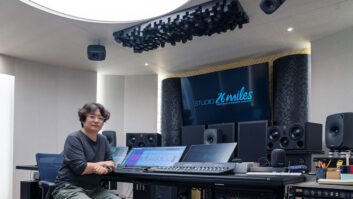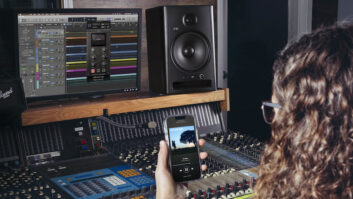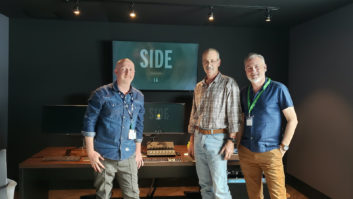Keeping MSR on the Right Track these days are (l-r): David Amlen, owner; Scott Kubrin, studio manager; and Bradshaw Leigh, chief engineer. NEW YORK, NY—To paraphrase Mark Twain’s oft-misquoted comment, reports of Right Track’s demise are greatly exaggerated. In fact, while the name may no longer be on the door buzzer at the facility’s Times Square-adjacent entrance, the rooms never stopped working and, now operating as MSR Studios, are as busy as ever.

To be fair, Right Track did go through some changes during its 30-plus-year lifetime. Established by the late Simon Andrews in 1976, it moved to its present West 48th Street location about five years later. The facility had grown to three rooms by 1990, with design assistance from in-house engineer and producer Frank Filipetti, hired in 1980, and attracted the likes of the Rolling Stones, Whitney Houston, James Taylor, Foreigner and others. In 2001, it expanded to include Studio A509 near the Javits Center, then got into financial trouble and merged with Sound on Sound, owned by David Amlen, in 2005, changing its name to Legacy Recording Studios the following year. A509 closed in 2008—like Sony Studios and The Hit Factory, a victim of Manhattan’s real estate boom— and Amlen became the sole owner in 2009, renaming it MSR Studios.
More recently, Amlen has appointed a new studio manager, Scott Kubrin, who has been running studios since 1993: Donald Fagen and Gary Katz’s River Sound; a stint in Atlanta with Brendan O’Brien; New York’s Battery Studios; and seven years at South Beach Studios with Tom Lord-Alge, then seven years at Lenny Kravitz’s Setai Recording, both in Miami.
“Scott came in with a fresh perspective, which you sometimes need. He said, ‘This place could use a touch up.’ A lot of clients hear with their eyes,” laughs Amlen. A lick of paint and some new carpet and MSR is once again ready to welcome clients.
Kubrin, who would see Pharrell Williams come in one week, Lady Gaga the next, followed by Justin Bieber then Jay-Z, while in Miami, is helping Amlen to tap into that same clientele. Meanwhile, Broadway cast recordings frequently book time in two rooms at a time. A509, with its 4,600-square-foot live room and five large iso booths, was previously the go-to facility for Broadway shows and movies. “So we had to get creative here,” says Amlen.
The solution was to use MSR’s A and B rooms. Studio A, outfitted with a 72-input SSL 9000 J and racks of outboard gear, offers a spacious, brick-walled tracking space and four iso booths. Down the hallway, Studio B houses a Euphonix System 5 and yet more outboard.
“But how do you do it when you have a room that’s a little less than half the size [of A509], and another room adjacent to it that’s maybe half the size of the first room? You’ve got all these iso booths, big control rooms; how do you make it work?” Amlen continues.
“We put in a huge amount of tielines, audio and video control, intercoms. We have full audio control, split-screen video of both rooms. It’s quite an intricate thing. We’ve adapted and our Broadway clientele have embraced it.”
“My first Broadway session was no different than any other session, just about a hundred times more moving parts,” says Kubrin. “I never once handled a session where we took two rooms and locked them together, with 100 people in here. But it went great.”
Studio C, with its 21-foot ceiling, offers an identical SSL console to A. While within the same complex, it is actually on Seventh Avenue. “I said to Dave, why don’t we turn this place into three one-room facilities?” says Kubrin. “So you can be totally isolated here; it has a private entrance and elevator.”
“As far as the gear goes, one of the great advantages we have is these three different rooms,” comments Bradshaw Leigh, the facility’s longtime chief engineer. “The reason we can survive is that they appeal to three completely different clientele. In the Euphonix room, you get the high-end jazz guys like Joe Frollo doing purist things, and Todd Whitelock scoring. They can mix a 250-channel film score to 48 stems. In C, you’ve got banging mains, and that keeps high profile R&B, hip-hop and pop stars happy. And in A, you’ve got the big room. So there’s a certain diversity just in the layout of the rooms and the gear.”
Amlen agrees: “We’ve had incredible success.” For example, D’Angelo recently wrapped a six-year session at the facility. “He actually started it in 2000. It just got a great review in the New York Times. And every year, we look at the Grammy and Tony award nominations and say—did it, did it, did it.”
Clients may be unfamiliar with the name, but once inside, they certainly recognize the studio. “Randy Jackson was in for the American Idol final last year. Aretha Franklin was live in Studio A, hooked up via satellite. Randy said, ‘I didn’t know you guys were still around. I did a lot of records here back in the day.’ We’re still here!”
MSR Studios
www.msrstudiosny.com







